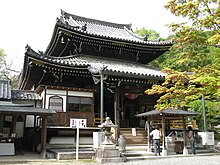Imakumano Kannon-ji
The Imakumano Kannon-ji ( Japanese. 今 熊 野 観 音 寺 ) or also Kannon-ji ( 観 音 寺 ) for short is a Buddhist temple in the Higashiyama-ku district of Kyoto in Japan . The temple is associated with the Shingon-shu belief . The main portrait of the temple is a statue of the eleven-headed Kannon . Imkumano Kannon-ji is the 15th temple on the Saigoku pilgrimage route ( 西 国 三十 三 箇 所 , Saigoku sanjūsankasho ).
overview
There is no historical evidence for the founding of Imakumano Kannon-ji. According to temple tradition, the temple should have been founded by the monk Kūkai in the Daidō period (806-810) as Kannon-ji. In the early days, the Imakumano Kannon-ji was mainly promoted by the statesman Fujiwara no Otsugu . Emperor Go-Shirakawa renamed the temple Shin Nachisan Kannon-ji ( 新 那 智 山 観 音 寺 ) and named the area around the temple Imakumano , from which the current name of the temple emerged.
Together with the nearby Imakumano shrine, the Imakumano Kannon-ji served the cult of the Kumano deities in medieval Kyoto. The temple was almost completely destroyed during the Ōnin war . Today's main hall dates from 1712.
The prayer to the Kannon statue of Imakumano Kannon-ji is said to have relieved Emperor Go-Shirakawa from severe headaches. Since that time, a visit to the temple has therefore enjoyed a reputation for promoting recovery from illnesses, particularly headaches and migraines.
The Imakumano Kannon-ji is closely connected with the neighboring Sennyū-ji , on whose grounds the tombs of the emperors Go-Horikawa and Kōmei are.
literature
- Patricia Frame Rugola: The Saikoku Kannon Pilgrimage Route . Dissertation, Ohio State University, 1986.
- Valeria Jana Schwanitz and August Wierling: Saigoku. On the way in Japan's western lands . Manpuku-Verlag, Potsdam 2012, ISBN 978-3-9815168-0-7 .
Web links
- Kannon Temple Official Website (Japanese)
Coordinates: 34 ° 58 ′ 46.9 ″ N , 135 ° 46 ′ 51 ″ E
